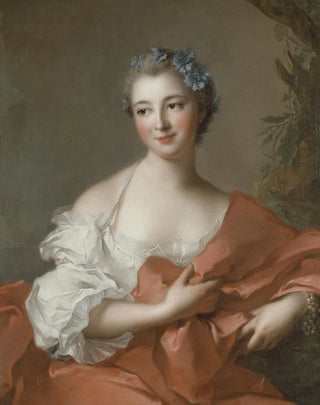Art print | Marquise de l'Hôpital - Jean-Marc Nattier


View from behind

Frame (optional)
Reproduction Marquise de l'Hôpital - Jean-Marc Nattier – Captivating introduction
The canvas "Marquise de l'Hôpital" by Jean-Marc Nattier is an iconic work of the 18th century, a true testament to the elegance and refinement of the era. Nattier, renowned for his portraits of women, manages to capture not only the physical beauty of his models but also their inner essence. The marquise, a central figure in this piece, presents herself with undeniable grace, her delicate features and penetrating gaze inviting the viewer to delve into her world. This piece, both intimate and majestic, embodies the spirit of a time when art and social life intertwined subtly. Contemplating this art print allows one to embark on a journey through time, into the heart of a vibrant French aristocracy.
Style and uniqueness of the work
Nattier's style is distinguished by its finesse and delicacy. Every brushstroke seems carefully chosen, contributing to an atmosphere of lightness and sophistication. The color palette, soft and harmonious, evokes a serenity emanating from the canvas. The marquise, dressed in a sumptuous gown adorned with refined details, is highlighted by a luminous background that enhances her radiance. Nattier skillfully plays with light and shadow, creating contrasts that bring the composition to life. This portrait is not merely a simple representation; it tells a story, that of a powerful and influential woman, while revealing the aesthetic norms of her time. The way Nattier captures the texture of fabrics and the softness of skin demonstrates his technical mastery, making this work a key piece of French portraiture.
The artist and his influence
Jean-Marc Nattier, born in 1685, is often regarded as one of the masters of portraiture in the 18th century. Trained at the school of classical art, he established himself in a competitive artistic environment. His talent for depicting female beauty earned him quick recognition, notably at the court of Louis XV. Nattier drew inspiration from the great masters of the past while developing

Matte finish

View from behind

Frame (optional)
Reproduction Marquise de l'Hôpital - Jean-Marc Nattier – Captivating introduction
The canvas "Marquise de l'Hôpital" by Jean-Marc Nattier is an iconic work of the 18th century, a true testament to the elegance and refinement of the era. Nattier, renowned for his portraits of women, manages to capture not only the physical beauty of his models but also their inner essence. The marquise, a central figure in this piece, presents herself with undeniable grace, her delicate features and penetrating gaze inviting the viewer to delve into her world. This piece, both intimate and majestic, embodies the spirit of a time when art and social life intertwined subtly. Contemplating this art print allows one to embark on a journey through time, into the heart of a vibrant French aristocracy.
Style and uniqueness of the work
Nattier's style is distinguished by its finesse and delicacy. Every brushstroke seems carefully chosen, contributing to an atmosphere of lightness and sophistication. The color palette, soft and harmonious, evokes a serenity emanating from the canvas. The marquise, dressed in a sumptuous gown adorned with refined details, is highlighted by a luminous background that enhances her radiance. Nattier skillfully plays with light and shadow, creating contrasts that bring the composition to life. This portrait is not merely a simple representation; it tells a story, that of a powerful and influential woman, while revealing the aesthetic norms of her time. The way Nattier captures the texture of fabrics and the softness of skin demonstrates his technical mastery, making this work a key piece of French portraiture.
The artist and his influence
Jean-Marc Nattier, born in 1685, is often regarded as one of the masters of portraiture in the 18th century. Trained at the school of classical art, he established himself in a competitive artistic environment. His talent for depicting female beauty earned him quick recognition, notably at the court of Louis XV. Nattier drew inspiration from the great masters of the past while developing






